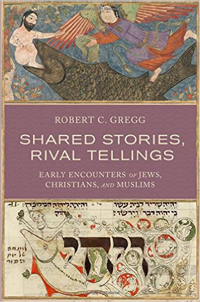 Robert C. Gregg, Shared Stories, Rival Tellings; Early Encounters of Jews, Christians, and Muslims (New York: Oxford University Press), 721pp.
Robert C. Gregg, Shared Stories, Rival Tellings; Early Encounters of Jews, Christians, and Muslims (New York: Oxford University Press), 721pp.
Many people have observed how the "Abrahamic" religions of Jews, Christians, and Muslims share important similarities. All three faiths are monotheistic. All three share a kinship with Ishmael. And all three are text-centered religions. In fact, observes Robert Gregg, there are twenty-seven sacred stories that are shared in the Hebrew Bible, the Christian Bible, and the Qur'an.
Gregg, Professor of Religious Studies and Classics emeritus at Stanford University since 1987 and a specialist in religious competition in the late Roman-early medieval period in the Mediterranean and Levant, explores in depth five of these shared stories — Cain and Abel, Sarah and Hagar, Joseph and Potiphar's wife, Jonah and the whale, and Mary the mother of Jesus. Each story begins with a brief preview, proceeds to a hundred-page analysis, and concludes with a comparative summary.
Gregg shows how the three traditions "differently heard, read, and used these [same] sacred stories" from the first to the sixteenth centuries. As you would expect, much of the book explores the work of the text-interpreters — story tellers, scholars, preachers, and teachers. But he also considers the artistic contributions of a stunning breadth of image-makers — the book contains over fifty plates of paintings, illuminated manuscripts, sculptures, sarcophagi, gems, cups and bowls, furniture, mosaics, and architecture. It's a breathtaking combination of the verbal and the visual.
The "trialogue" between all these "meaning-seekers" pushed and pulled in different directions. On the one hand, the sacred stories helped to form the internal development of each tradition, and in particular their claims to a unique identity. "Telling, retelling, and refashioning sacred narratives," writes Gregg, "were intentional efforts at reinforcing each community's core beliefs, codes of behavior, and modes of worship."
On the other hand, the shared stories also functioned to differentiate and draw boundaries, to oppose and repudiate, to confront one's religious competitors. That is, the interpreters sought to "defend their respective faiths' belief systems against attacks and, whenever possible, to score victories over their opponents' arguments." It's enlightening to realize just how much believers knew about and interacted with alternate versions of their "own" stories.
And thus the scandal of historical particularity. The oft-heard and patronizing idea that Jews, Christians, and Muslims mean the same thing when they tell their scared stories is precisely what they don't do. Yes, the three traditions shared the same sacred stories, but they also "lived by rival interpretations of them."
Gregg, who was also dean of religious life at Stanford for twelve years and is an ordained Episcopal priest, concludes with a provocative suggestion: "Perhaps interreligious conversations in our era would more honestly proceed by taking up difficult and irreconcilable variances in belief and practices, working toward understanding — even appreciation — of these. Notions of an essential and unbreakable familial closeness and concord that enwraps Jews, Christians, and Muslims are romantic, and also historically false."


